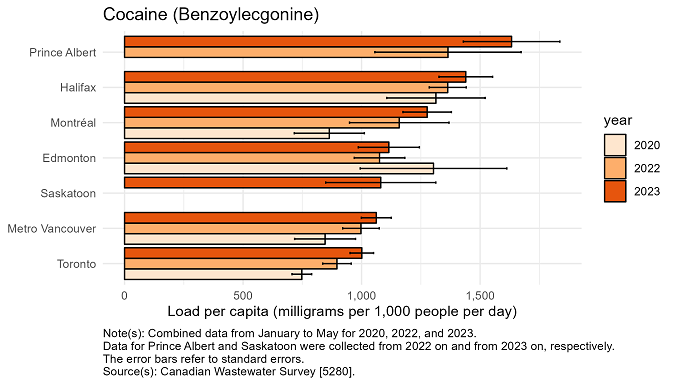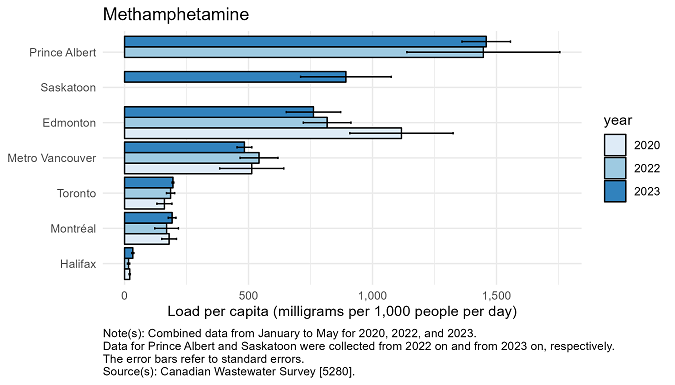Stimulant drug use is reported to be contributing significantly to accidental drug toxicity deaths in Canada. In fact, as drug overdoses increased by more than 30% from 2020 to 2021, the latest report from Health Canada on Opioid- and Stimulant-related Harms in Canada indicates that approximately half of apparent accidental opioid toxicity deaths also involved a stimulant.
Stimulants include controlled drugs like cocaine (“coke”), methamphetamine (“crystal meth”), MDMA (“ecstasy”) and amphetamines (“speed” or “uppers”). Amphetamines are also available by prescription to treat conditions such as attention deficit/hyperactivity disorder (ADHD).
Amphetamine measured in wastewater had increased significantly prior to 2023 in certain Canadian cities. However, early results in 2023 suggest that amphetamine levels may have stabilized. On the other hand, cocaine levels have continued to increase into 2023.
These observations are based on new data released today from the Canadian Wastewater Survey (CWS). The CWS has regularly been collecting wastewater samples from several municipalities across the country since 2019 to test for various drugs, including stimulants. The release today includes new data for 2022 as well as provisional data for the months of January, March, and May 2023 as part of Statistics Canada’s commitment to more timely and relevant data. Wastewater-based estimates of drug use have traditionally been used to assess longer-term trends, for example year-to-year comparisons. However, in the context of an ongoing drug crisis in some parts of Canada, wastewater data can provide nearly real-time information which contributes to a better understanding of current drug use and emerging trends. This information can help inform more targeted public health responses and law enforcement activities.
Cocaine use continuing to show signs of increase across Canada
In most municipalities, cocaine levels increased from January to May 2022 compared with the same period in 2020 (Infographic 1). Provisional results from 2023 also suggest the trend of increasing levels of cocaine use continues in most municipalities.
Infographic 1
Combined cocaine (benzoylecgonine) daily load per capita for Halifax, Montréal, Toronto, Saskatoon, Prince Albert, Edmonton, and Metro Vancouver from January to May in 2020, 2022, and 2023

Wastewater monitoring for drug use has been ongoing in cities across the globe for many years. For example, the European Monitoring Center for Drugs and Drug Addiction monitors wastewater in over 150 cities across 28 countries across the continent. Compared with the European cities included in their analysis, with populations of more than 100,000 people, 5 Canadian cities would rank among the top 10 with the highest levels of cocaine in wastewater (Infographic 2). The United Nations 2023 Global Report on Cocaine indicates that half a million Canadians reported using cocaine in 2022 and that cocaine is highly available in Canada. Moreover, Canada had a lower retail price for cocaine than many other countries.
Infographic 2
Cocaine in European cities and in Canadian cities

Canadian cities also displayed very large levels of methamphetamine (“crystal meth”) compared with cities in other countries worldwide. Among countries with available wastewater data that use comparable methodology, cities in the United States, Czechia, Australia, Canada, and New Zealand had the highest levels of methamphetamine use in 2022.
Methamphetamine has not shown signs of increased use in recent years, while amphetamine levels showed a marked increase from 2020 to 2022
Methamphetamine is a stimulant drug that is both potent and highly addictive. Amphetamine is a metabolite in the breakdown of methamphetamine which implies that methamphetamine use contributes very significantly to amphetamine levels in wastewater.
Although methamphetamine use in Canada in 2022 was higher compared with some international cities, use in Canada has not changed significantly in recent years (Infographic 3).
Infographic 3
Combined methamphetamine daily load per capita for Halifax, Montréal, Toronto, Saskatoon, Prince Albert, Edmonton, and Metro Vancouver in the months January to May in 2020, 2022, and 2023

On the other hand, average wastewater levels of amphetamine were significantly higher in the first half of 2022 compared with the same time in 2020 in Montréal and other cities such as Toronto and Metro Vancouver (Infographic 4). Average levels in the first half of 2022 were also higher in Halifax, though the difference was not as large. As these increased levels of amphetamine in wastewater do not correspond with an increase in methamphetamine levels, this implies there was an increased use of amphetamine and other amphetamine-related drugs, which could include medications used for ADHD. Further research is needed to better understand whether this is primarily from increased prescription or illicit amphetamine drug use (i.e., recreational and other non-medical uses).
So far in 2023, there were not large differences in methamphetamine or amphetamine levels compared with 2022.
Infographic 4
Combined amphetamine daily load per capita for Halifax, Montréal, Toronto, Saskatoon, Prince Albert, Edmonton, and Metro Vancouver in the months January to May in 2020, 2022, and 2023

Methamphetamine, amphetamine use highest in cities in the Prairies
On average, both methamphetamine and amphetamine levels have been consistently higher in cities in the prairies (Edmonton, as well as Prince Albert and Saskatoon) compared with the other cities participating in the CWS. Prince Albert had the highest average levels for January to May in 2022 and 2023.





